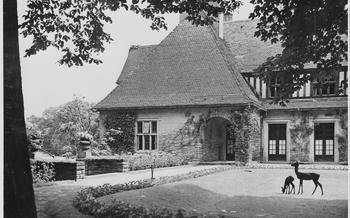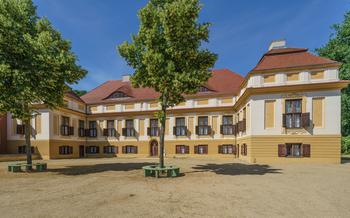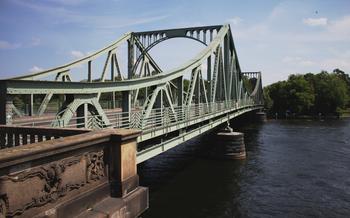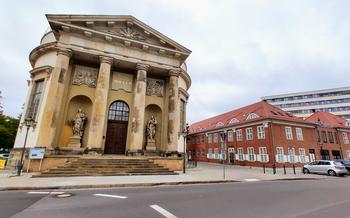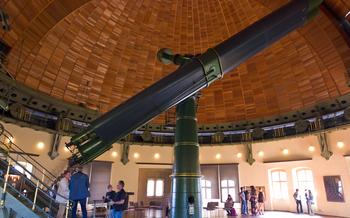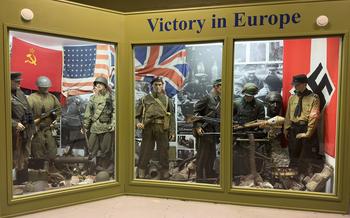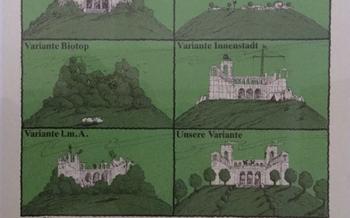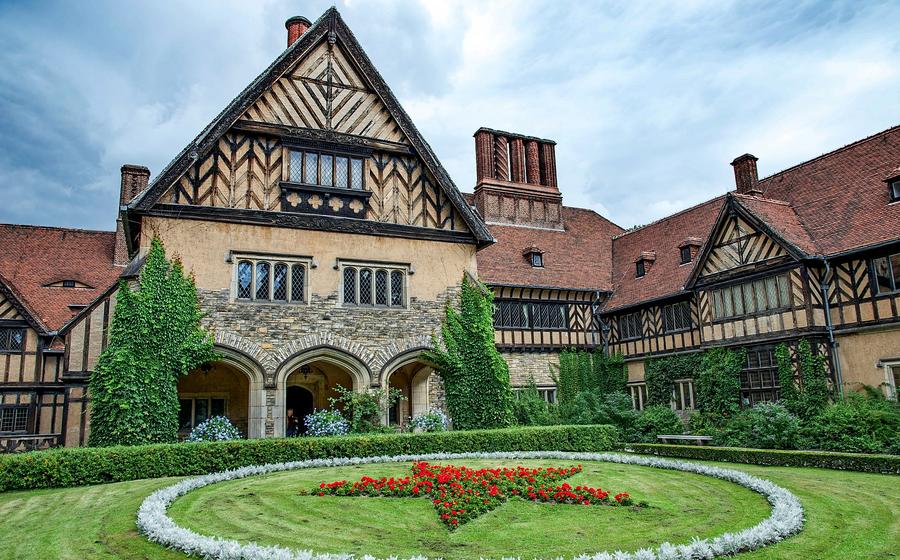
Cecilienhof Palace
- A Royal Residence:
- World War II Significance:
- Gardens and Landscape
- Architecture and Interiors
- Historical Context
- Film and Media Appearances
- Surrounding Attractions
- Admission and Fees
- Accessibility and Transportation
- Photography and Social Media
- Souvenirs and Merchandise
- Food and Refreshments
- Insider Tip:
A Royal Residence:
Cecilienhof Palace stands as a testament to German royalty and architectural grandeur. Built between 1914 and 1917, it was commissioned by Wilhelm, the Crown Prince of Prussia, as a gift to his wife, Duchess Cecilie. The palace reflects the Hohenzollern dynasty's opulence and power, blending traditional German architecture with modern English country house influences. Its striking gabled roof, half-timbered facades, and picturesque gardens create a captivating ensemble that has become a symbol of Potsdam's rich heritage. Today, Cecilienhof serves as a museum, inviting visitors to step into the world of German royalty and experience the grandeur of this remarkable palace.
World War II Significance:
Cecilienhof Palace holds immense historical significance as the venue for the Potsdam Conference in July 194This high-stakes gathering brought together the leaders of the Allied powers—President Harry S. Truman of the United States, Prime Minister Winston Churchill of the United Kingdom, and General Secretary Joseph Stalin of the Soviet Union—to discuss the aftermath of World War II and shape the postwar world order.
During the conference, held in the palace's elegant rooms, the leaders deliberated on crucial issues such as the division of Germany, the establishment of occupation zones, and the fate of war criminals. The decisions made at Potsdam had a profound impact on the geopolitical landscape of Europe and the Cold War that ensued.
The palace's association with this pivotal event has imbued it with a symbolic significance, serving as a reminder of the complex negotiations and power dynamics that shaped the course of history. Today, visitors can explore the conference rooms where these momentous discussions took place, gaining a deeper understanding of the decisions that shaped the world we live in.
Gardens and Landscape
The Cecilienhof Palace boasts breathtaking gardens that seamlessly blend with the surrounding Sanssouci Park, creating a harmonious ensemble. The palace's landscape design is a testament to the skill and vision of renowned landscape architects. Visitors are captivated by the meticulous layout of the gardens, featuring winding paths, manicured lawns, and an array of vibrant flowerbeds.
The gardens are adorned with exquisite sculptures and water elements, adding a touch of elegance and serenity to the surroundings. Visitors can admire the graceful statues that adorn the palace grounds, each one telling a unique story. Water plays a vital role in the garden's design, with tranquil ponds and fountains providing a soothing backdrop to the lush greenery.
The integration of the gardens with the surrounding parkland creates a sense of vastness and tranquility. Visitors can stroll through the gardens, enjoying the vibrant colors and fragrant blooms, before venturing into the sprawling Sanssouci Park, with its majestic palaces, idyllic lakes, and serene walkways.
Architecture and Interiors
The Cecilienhof Palace boasts a distinctive architectural style that masterfully blends traditional and contemporary elements. Its exterior showcases a striking mix of red brick and white stone, creating a visually appealing contrast. The palace's most prominent feature is its tower, which offers panoramic views of the surrounding landscape. The entrance hall, known as the Marmorhalle, is a testament to grandeur, featuring marble floors, intricate carvings, and a stunning chandelier. The interior design of the palace is equally impressive, with each room showcasing unique furnishings and decor. The influence of various artistic movements, from Art Nouveau to Bauhaus, can be seen throughout the palace, resulting in a harmonious blend of styles.
Historical Context
The Cecilienhof Palace has a rich and storied history, dating back to its construction in the early 20th century. Commissioned by Crown Prince Wilhelm, the palace was designed by architect Paul Schultze-Naumburg and completed in 191It was intended as a summer residence for the Hohenzollern family, who ruled Germany and Prussia for centuries. The palace's design reflects the transition from the traditional Prussian style to a more modern and informal approach, blending elements of English Tudor and Dutch Renaissance architecture.
Throughout its history, the Cecilienhof Palace has witnessed significant events and hosted influential figures. During World War I, it served as a military hospital, and after the war, it became the residence of Crown Prince Wilhelm and his wife, Duchess Cecilie of Mecklenburg-Schwerin. In 1945, the palace played a pivotal role in world history as the venue for the Potsdam Conference, where the leaders of the Allied powers—President Harry Truman of the United States, Prime Minister Winston Churchill of the United Kingdom, and General Secretary Joseph Stalin of the Soviet Union—met to discuss the postwar order in Europe.
After the war, the palace was used by the Soviet military and later fell into disrepair. In the 1990s, it underwent extensive renovations and was restored to its former glory. Today, the Cecilienhof Palace stands as a testament to Germany's rich history and serves as a popular tourist destination, offering visitors a glimpse into the lives of the Hohenzollern dynasty and the events that shaped the course of world history.
Film and Media Appearances
Cecilienhof Palace's striking architecture and historical significance have made it a popular backdrop for movies, television shows, and documentaries. The palace's unique ambiance and well-preserved interiors have captivated filmmakers seeking authentic historical settings. Notable productions that have featured the palace include the 2007 film "The Bourne Ultimatum," where it served as the residence of the Russian president, and the 2015 TV series "Deutschland 83," which depicted the palace as the venue for a crucial meeting between East German and West German officials. These appearances have further elevated the palace's profile, attracting visitors interested in experiencing the locations seen on screen.
Surrounding Attractions
The Cecilienhof Palace is situated in the heart of Potsdam, a city renowned for its cultural treasures and historical significance. Visitors to the palace can easily combine their visit with explorations of other nearby attractions, creating a well-rounded itinerary.
Within walking distance of the palace, you'll find the Sanssouci Park, a UNESCO World Heritage Site and one of the most beautiful parks in Germany. The park is home to several other palaces, including the Sanssouci Palace, the Neues Palais, and the Charlottenhof Palace.
Other nearby attractions include the Glienicke Bridge, a historic bridge that connects Potsdam to Berlin, and the Babelsberg Park, another beautiful park with a variety of gardens and sculptures.
For those interested in learning more about Potsdam's history, the Potsdam Museum offers a comprehensive overview of the city's past. The museum is housed in a former royal palace and features exhibits on everything from the city's founding to its role in the Cold War.
Potsdam is well-connected by public transportation, making it easy to visit multiple attractions in a single day. The city also offers a variety of guided tours that can help you make the most of your visit.
Admission and Fees
Visiting Cecilienhof Palace requires purchasing an entrance ticket. Prices vary depending on the season and type of tour. General admission tickets for adults typically range from 8 to 10 euros, while concessions for students, seniors, and children may receive discounts. Guided tours are available at an additional cost, providing a more in-depth experience with expert commentary.
To avoid disappointment and ensure a smooth visit, advance booking is recommended, especially during peak tourist season. Online ticketing platforms often offer the convenience of selecting a specific time slot and securing your spot. Remember to check the palace's official website or authorized ticket sellers for the most up-to-date information on pricing, discounts, and availability.
Budget-conscious travelers can take advantage of combination tickets that bundle admission to Cecilienhof Palace with other attractions in Potsdam, such as the nearby Sanssouci Palace or the Picture Gallery. These packages often provide significant savings and allow for a more comprehensive exploration of the city's cultural heritage.
Accessibility and Transportation
The Cecilienhof Palace is situated in the Neuer Garten, a beautiful park in Potsdam, Germany. Visitors can conveniently reach the palace using public transportation, making it easily accessible from various parts of the city. The nearest bus stop, "Cecilienhof," is just a short walk away, and several bus lines connect to the palace. Alternatively, visitors can take the tram to the "Glienicker Brücke" stop and enjoy a scenic walk through the park to reach the palace. For those traveling by car, ample parking is available near the palace. The parking lot is spacious and offers designated spaces for visitors with disabilities. The palace is wheelchair accessible, with ramps and elevators ensuring that visitors of all abilities can comfortably explore the palace's interior.
Photography and Social Media
With its captivating architecture, picturesque gardens, and rich history, Cecilienhof Palace is a photographer's paradise. The palace's exterior, with its striking tower and red brick facade, provides ample opportunities for capturing grand shots. The interior, with its elegant rooms and intricate details, is equally photogenic. Visitors are welcome to take photographs inside the palace, except in designated areas where photography is restricted.
To share your Cecilienhof experience with the world, use the hashtag #CecilienhofPalace on social media platforms. This will allow you to connect with other visitors, share your photos, and discover new perspectives on this iconic landmark. Remember to tag the palace's official social media accounts, @CecilienhofPalace, to ensure that your photos are seen by a wider audience.
When taking photographs, be mindful of other visitors and their privacy. Refrain from using flash photography, as it can be disruptive and damaging to the palace's interiors. Follow the etiquette guidelines displayed throughout the palace to ensure a respectful and enjoyable visit for everyone.
Souvenirs and Merchandise
At the Cecilienhof Palace, visitors can find a treasure trove of souvenirs and merchandise to commemorate their visit. The on-site gift shop offers an assortment of items, including postcards, magnets, keychains, and books related to the palace's history and architecture. For those seeking unique souvenirs, the shop also carries exclusive items such as replicas of the palace's furniture and artwork. To find the best selection and avoid disappointment, it's advisable to visit the gift shop early during your visit. Budget-conscious travelers can opt for postcards or magnets, while those looking for something special can consider purchasing a piece of jewelry inspired by the palace's design or a book detailing its fascinating history.
Food and Refreshments
After exploring the magnificent Cecilienhof Palace and its captivating gardens, visitors can indulge in culinary delights at various dining options. The palace itself houses a charming café, offering a tempting array of refreshments, including aromatic coffee, refreshing beverages, and delectable pastries. Guests can savor these treats while basking in the ambiance of the historic surroundings.
For a more substantial meal, visitors can venture outside the palace gates to discover a diverse culinary scene. In the immediate vicinity, there are numerous restaurants and cafes catering to a range of tastes and preferences. From traditional German cuisine to international flavors, visitors are spoiled for choice. Whether seeking a hearty schnitzel, a flavorful pasta dish, or a light salad, there's something to satisfy every palate.
For those seeking a more immersive experience, a picnic in the picturesque gardens of Cecilienhof Palace is a delightful option. Visitors can pack a hamper filled with local delicacies and find a secluded spot to enjoy their meal surrounded by nature's beauty. The gardens offer ample space for leisurely picnics, providing a serene and memorable dining experience.
Insider Tip:
-
Embark on a guided tour to uncover the palace's hidden stories. The knowledgeable guides provide fascinating insights into the history, architecture, and significance of Cecilienhof Palace, bringing the past to life.
-
Explore the palace's surroundings by bike. Rent a bicycle from one of the nearby rental shops and embark on a picturesque journey through the scenic parkland, discovering hidden paths and tranquil spots away from the crowds.
-
Visit the palace during the off-season (November to March) to experience a more intimate and serene atmosphere. Take advantage of the smaller crowds to leisurely explore the interiors and gardens without the summer rush.
-
Keep an eye out for special events and exhibitions held at the palace throughout the year. These events offer a unique opportunity to experience the palace in a different light, with themed tours, historical reenactments, or art installations.
-
Don't miss the chance to capture stunning photographs of the palace, especially during the golden hour of sunrise or sunset. The warm hues cast a magical glow on the palace, creating a picture-perfect moment.
